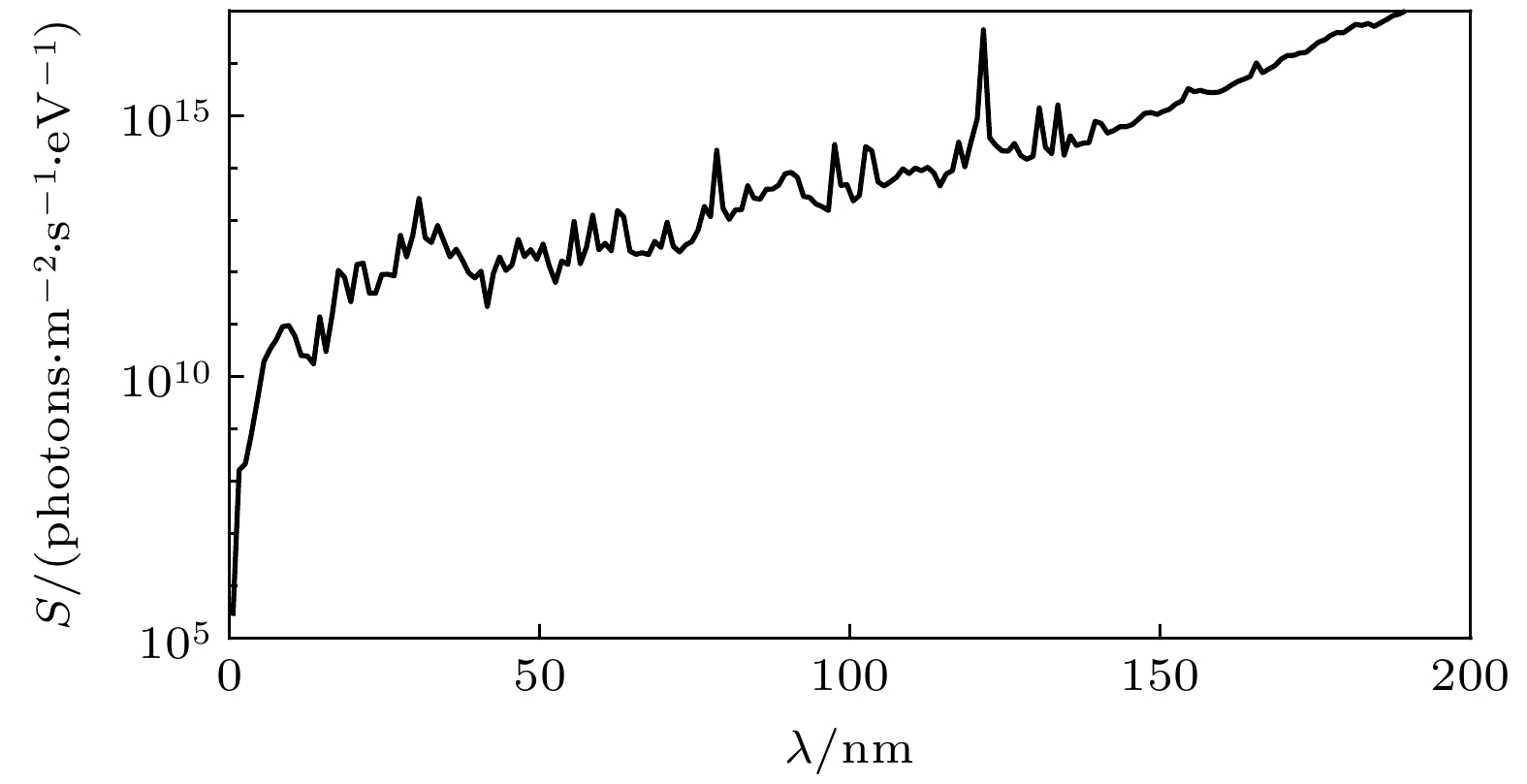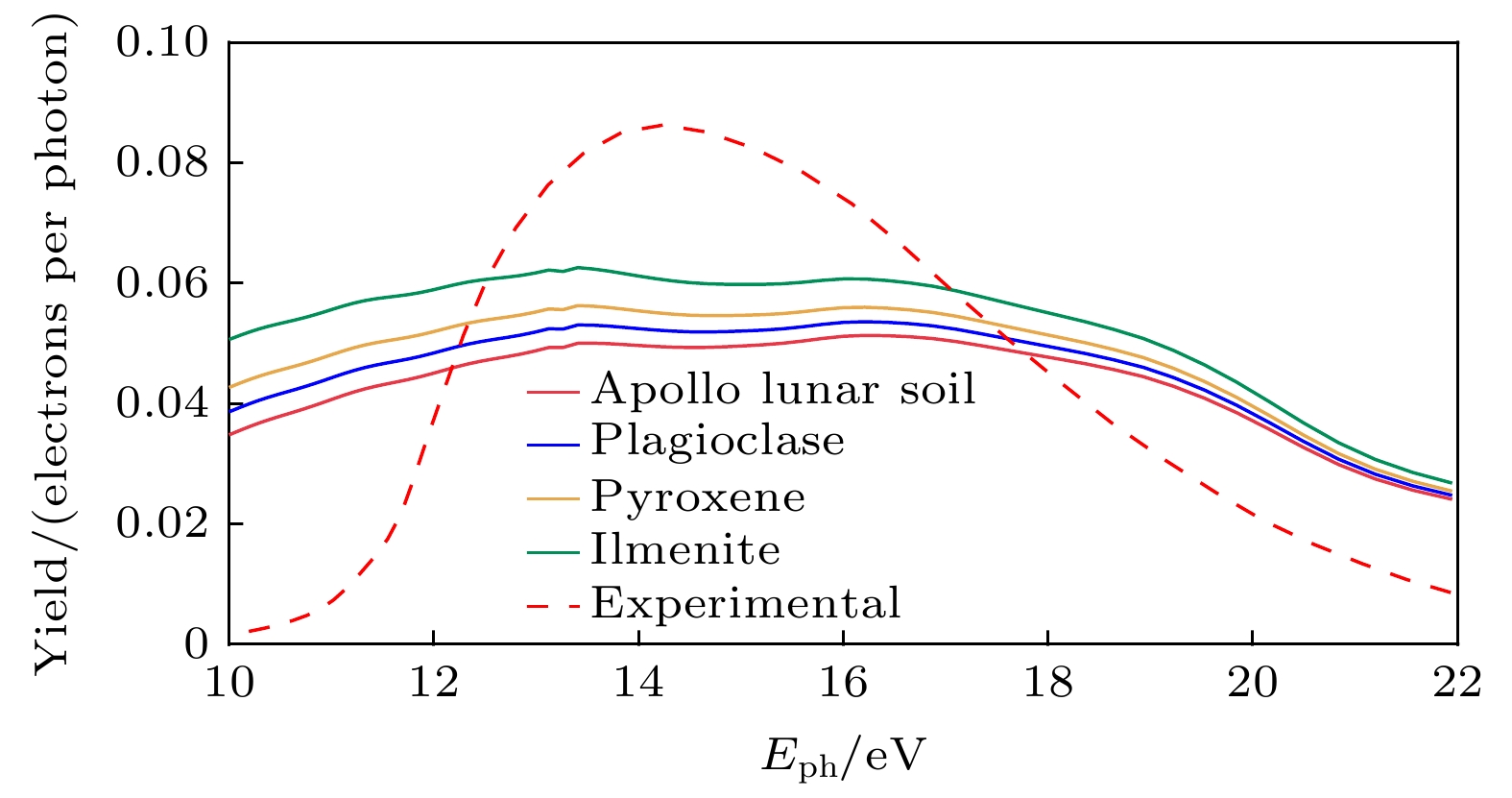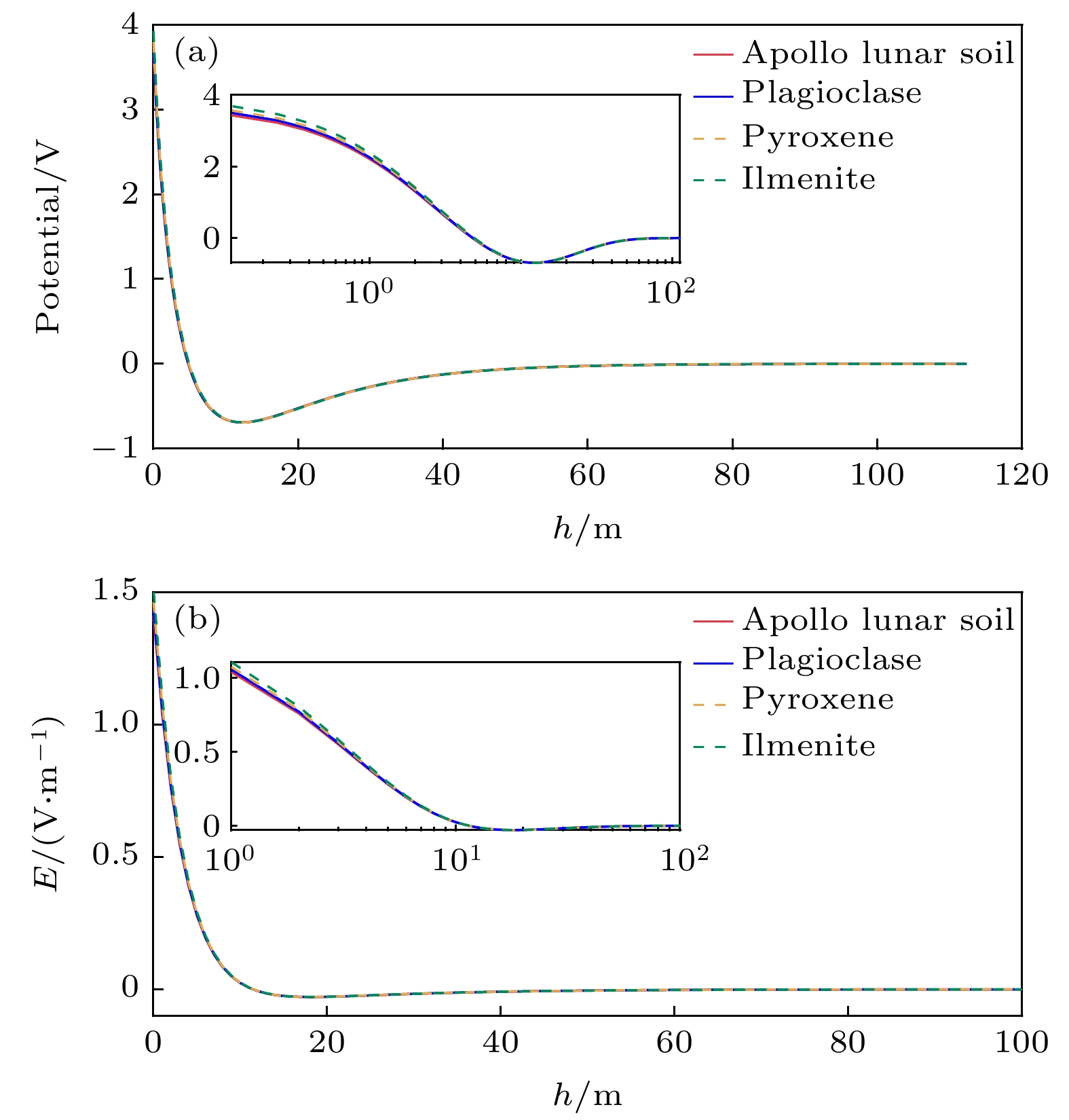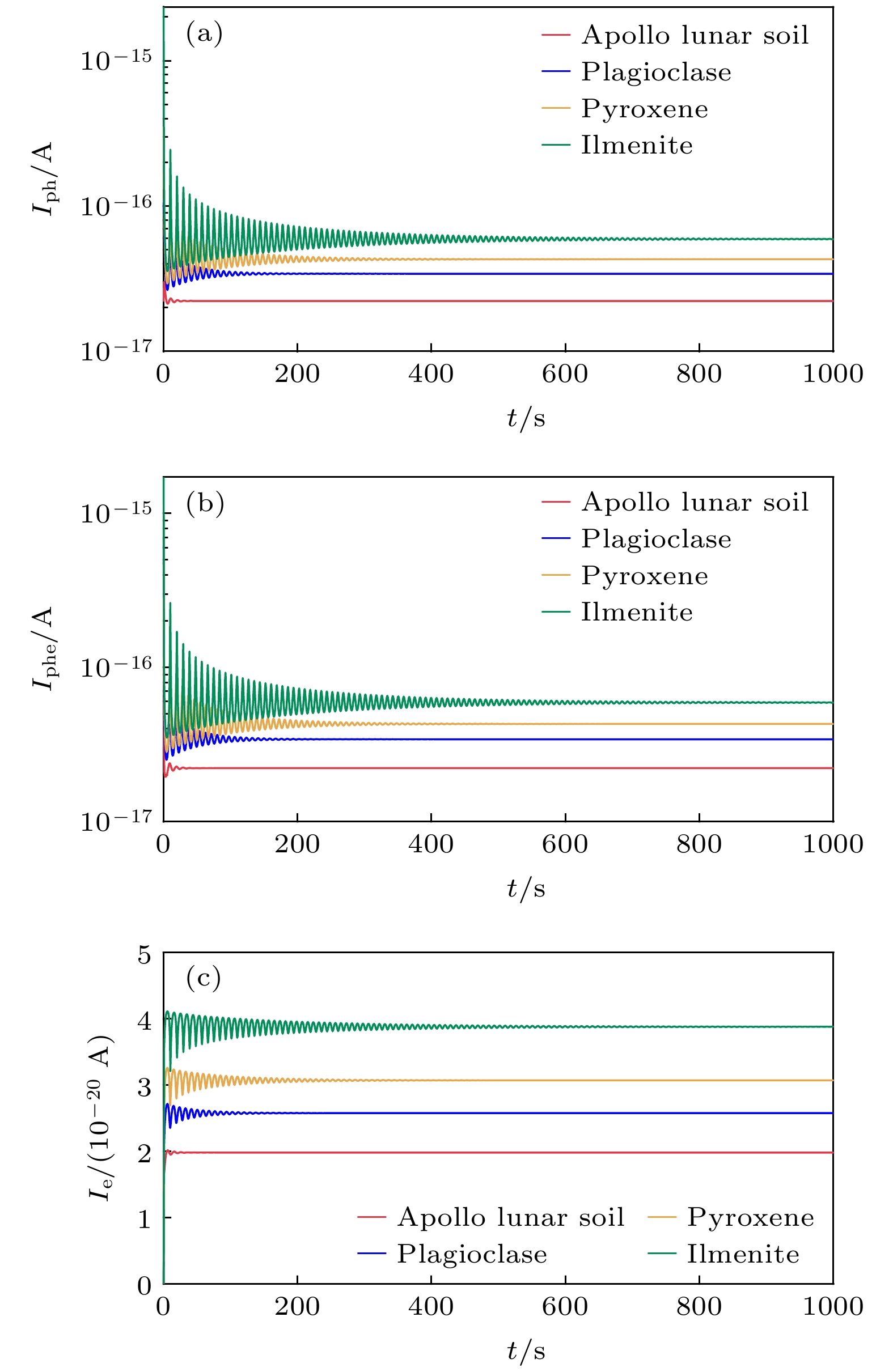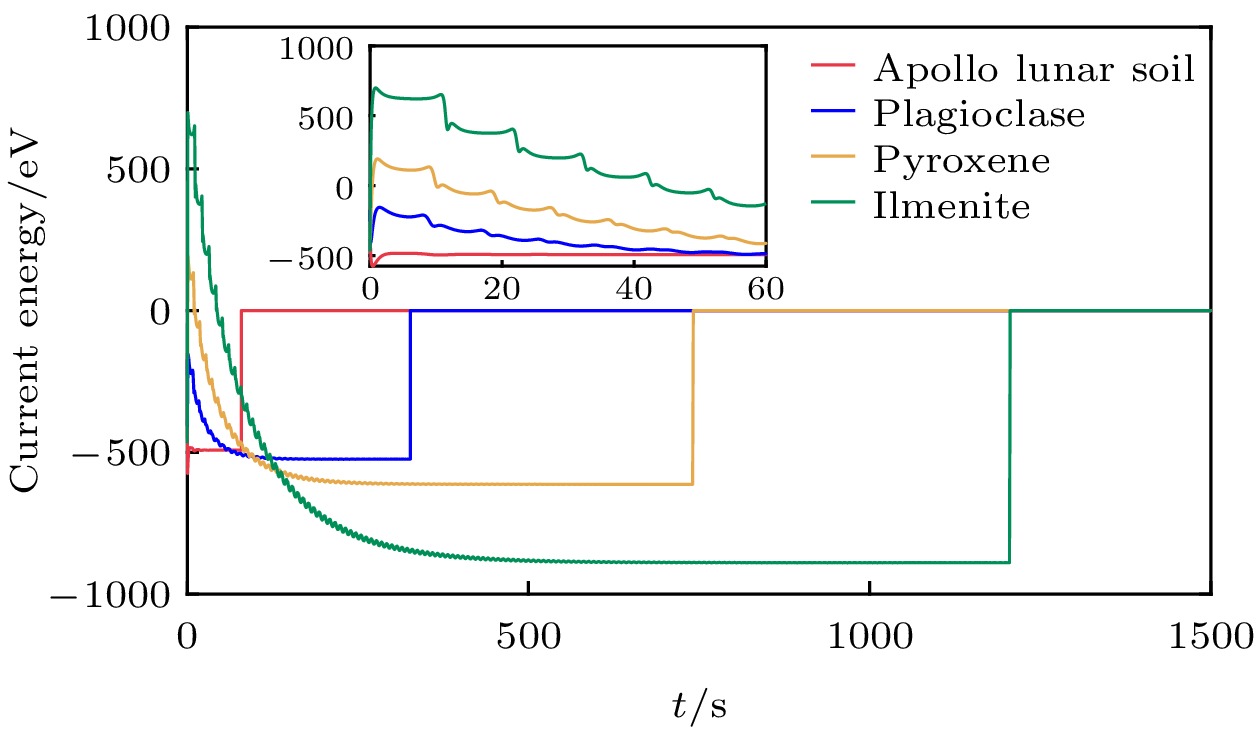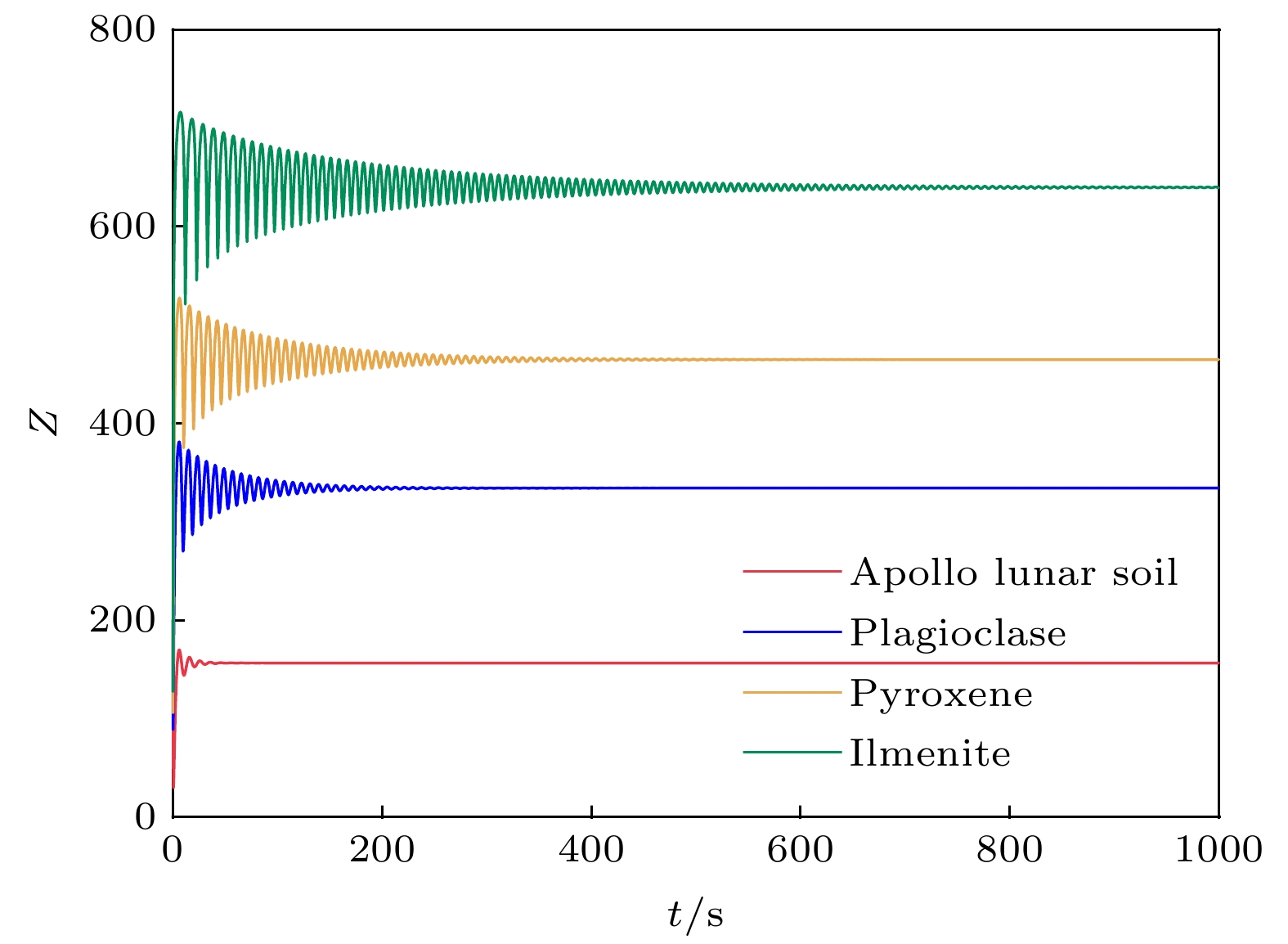-
月球表面的带电尘埃对太空任务的顺利实施构成严重威胁, 对尘埃的充电和动力学的进一步研究有助于月球探测任务的顺利实施. 本文研究了具有不同功函数的尘埃颗粒在月球表面的充电和动力学. 重新计算了与4种尘埃颗粒功函数相关的表面充电电流, 并得到了它们在不同太阳天顶角下的充电和动力学结果, 揭示了尘埃颗粒充电和动力学结果对功函数的依赖性. 结果显示具有较小功函数的尘埃颗粒能够达到较大的平衡态, 且需要更长时间才能达到这些平衡态, 其中包括尘埃颗粒能够稳定悬浮的平衡高度, 能够携带的表面电荷量以及流经尘埃颗粒表面的充电电流. 结果表明, 当太阳天顶角在0°—90°范围内变化时, 平衡态与功函数之间都呈现明显的反比关系. 尘埃颗粒在临界太阳天顶角下不能发生稳定悬浮, 且该角度的大小与功函数也呈反比关系.Charged dust on the lunar surface poses a threat to space missions. Research into charged dust is essential for the safety of future space missions. When calculating the charging currents related to photoelectrons, a single constant work function is assumed in the conventional lunar dust charging theory. However, the components of lunar regolith exhibit considerable diversity, including plagioclase, pyroxene, and ilmenite. Because the ability of the lunar surface or lunar dust to emit photoelectrons strongly depends on its work function, it is necessary to analyze the effect of the work function on dust charging and dynamics near the lunar surface. In this work, we use a novel method that can predict the photoelectric yield of materials with different work functions to recalculate the surface charging currents of four types of dust particles and derive their subsequent charging and dynamic results at different solar zenith angles (SZAs). As SZA varies from 0° to 90°, the work function value of dust decreases into 6 eV (Apollo lunar soil), 5.58 eV (plagioclase), 5.14 eV (pyroxene), and 4.29 eV (ilmenite), correspondingly. With each decrement in work function, the equilibrium charging current of dust particles increases about 0.25 times, the equilibrium charge number increases about 120–170 elemental charges, and the equilibrium height increases about 0.3–2 m. It is found that dust particles cannot levitate stably at a critical SZA, and the critical SZAs for the four types of dust particles are 28°, 76°, 85.8°, and 89.6°, respectively (arranged in decreasing order of work functions). These results indicate that the equilibrium heights, equilibrium currents, and critical SZAs all have an inverse relationship with the work function of dust particles as the SZA varies from 0° to 90°. Furthermore, a higher photoelectron density in areas with lower work functions leads energy losses to decrease, thus causing dust particles to take longer time to reach equilibrium. This means that the equilibrium time follows the pattern similar to that of the work function.
-
Keywords:
- moon /
- dust levitation /
- work function
[1] Zakharov A V, Popel S I, Kuznetsov I A, Borisov N D, Rosenfeld E V, Skorov Y, Zelenyi L M 2022 Phys. Plasmas 29 110501
 Google Scholar
Google Scholar
[2] Xia Q, Cai M H, Xu L L, Han R L, Yang T, Han J W 2022 Chin. Phys. B 31 045201
 Google Scholar
Google Scholar
[3] Grard R, Tunaley J 1971 J. Geophys. Res. 76 2498
 Google Scholar
Google Scholar
[4] Nitter T, Havnes O 1992 Earth Moon and Planets 56 7
 Google Scholar
Google Scholar
[5] Nitter T, Havnes O, Melands F 1998 J. Geophys. Res.: Space Phys. 103 6605
 Google Scholar
Google Scholar
[6] Colwell J, Batiste S, Horányi M, Robertson S, Sture S 2007 Rev. Geophys. 45 RG2006
 Google Scholar
Google Scholar
[7] Lee P 1996 Icarus 124 181
 Google Scholar
Google Scholar
[8] Walbridge E 1973 J. Geophys. Res. 78 3668
 Google Scholar
Google Scholar
[9] Whipple E C 1981 Rep. Prog. Phys. 44 1197
 Google Scholar
Google Scholar
[10] Wang X, Horányi M, Robertson S 2009 J. Geophys. Res.:Space Phys. 114 A05103
 Google Scholar
Google Scholar
[11] Wang X, HoráNyi M, Robertson S 2010 J. Geophys. Res.: Space Phys. 115 A11102
 Google Scholar
Google Scholar
[12] Wang X, Horányi M, Robertson S 2011 Planet. Space Sci. 59 1791
 Google Scholar
Google Scholar
[13] Wang X, Schwan J, Hsu H W, Grün E, Horányi M 2016 Geophys. Res. Lett. 43 6103
 Google Scholar
Google Scholar
[14] Wang X, Pilewskie J, Hsu H W, Horányi M 2016 Geophys. Res. Lett. 43 525
 Google Scholar
Google Scholar
[15] Schwan J, Wang X, Hsu H W, Grün E, Horányi M 2017 Geophys. Res. Lett. 44 3059
 Google Scholar
Google Scholar
[16] Zimmerman M I, Farrell W M, Hartzell C M, Wang X, Horanyi M, Hurley D M, Hibbitts K 2016 J. Geophys. Res.: Planets 121 2150
 Google Scholar
Google Scholar
[17] Hartzell C, Zimmerman M, Hergenrother C 2022 Planet. Sci. J. 3 85
 Google Scholar
Google Scholar
[18] Golub’ A P, Dol’nikov G G, Zakharov A V, Zelenyi L M, Izvekova Y N, Kopnin S I, Popel S I 2012 Jetp. Lett. 95 182
 Google Scholar
Google Scholar
[19] Popel S I, Kopnin S I, Golub’ A P, Dol’nikov G G, Zakharov A V, Zelenyi L M, Izvekova Y N 2013 Sol. Syst. Res. 47 419
 Google Scholar
Google Scholar
[20] Popel S I, Golub’ A P, Zakharov A V, Zelenyi L M 2019 J. Phys. : Conf. Ser. 1147 012110
 Google Scholar
Google Scholar
[21] Zelenyi L M, Popel S I, Zakharov A V 2020 Plasma Phys. Rep. 46 527
 Google Scholar
Google Scholar
[22] Hess S L G, Sarrailh P, Mateo-Velez J C, Jeanty-Ruard B, Cipriani F, Forest J, Hilgers A, Honary F, Thiebault B, Marple S R, Rodgers D 2015 IEEE Trans. Plasma Sci. 43 2799
 Google Scholar
Google Scholar
[23] Kuznetsov I A, Hess S L G, Zakharov A V, Cipriani F, Seran E, Popel S I, Lisin E A, Petrov O F, Dolnikov G G, Lyash A N, Kopnin S I 2018 Planet. Space Sci. 156 62
 Google Scholar
Google Scholar
[24] Davari H, Farokhi B, Ali Asgarian M 2023 Sci. Rep. 13 1111
 Google Scholar
Google Scholar
[25] Piquette M, Horányi M 2017 Icarus 291 65
 Google Scholar
Google Scholar
[26] 李梦谣, 夏清, 蔡明辉, 杨涛, 许亮亮, 贾鑫禹, 韩建伟 2024 73 155201
 Google Scholar
Google Scholar
Li M Y, Xia Q, Cai M H, Yang T, Xu L L, Jia X Y, Han J W 2024 Acta Phys. Sin. 73 155201
 Google Scholar
Google Scholar
[27] Zhao C, Gan H, Xie L, Wang Y, Wang Y, Hong J 2023 Sci. China: Earth Sci. 66 2278
 Google Scholar
Google Scholar
[28] Gan H, Wei G F, Zhang W W, Li X Y, Jiang S Y, Wang C, Ma J N, Zhang X P 2023 Sci. China: Phys. Mech. Astron. 53 127
 Google Scholar
Google Scholar
[29] Li L, Zhang Y T, Zhou B, Feng Y Y 2016 Sci. China: Earth Sci. 59 2053
 Google Scholar
Google Scholar
[30] Popel S I, Golub’ A P, Izvekova Y N, Afonin V V, Dol’nikov G G, Zakharov A V, Zelenyi L M, Lisin E A, Petrov O F 2014 Jetp. Lett. 99 115
 Google Scholar
Google Scholar
[31] Mishra S K 2020 Phys. Plasmas 27 082906
 Google Scholar
Google Scholar
[32] Feuerbacher B, Anderegg M, Fitton B, Laude L D, Willis R F, Grard R J L 1972 Lunar and Planetary Science Conference Proceedings 3 2655
[33] Sternovsky Z, Robertson S, Sickafoose A, Colwell J, Horányi M 2002 J. Geophys. Res.: Planets 107 5105
 Google Scholar
Google Scholar
[34] Sternovsky Z, Chamberlin P, Horanyi M, Robertson S, Wang X 2008 J. Geophys. Res.: Space Phys. 113 A10104
 Google Scholar
Google Scholar
[35] Kimura H 2016 Mon. Not. R. Astron. Soc. 459 2751
 Google Scholar
Google Scholar
[36] Seah M P, Dench W 1979 Surf. Interface Anal. 1 2
 Google Scholar
Google Scholar
[37] Senshu H, Kimura H, Yamamoto T, Wada K, Kobayashi M, Namiki N, Matsui T 2015 Planet. Space Sci. 116 18
 Google Scholar
Google Scholar
[38] Chamberlin P C, Woods T N, Eparvier F G 2007 Space Weather 5 S07005
 Google Scholar
Google Scholar
[39] Rakesh Chandran S B, Veenas C L, Asitha L R, Parvathy B, Rakhimol K R, Abraham A, Rajesh S R, Sunitha A P, Renuka G 2022 Adv. Space Res. 70 546
 Google Scholar
Google Scholar
[40] Stubbs T J, Farrell W M, Halekas J S, Burchill J K, Collier M R, Zimmerman M I, Vondrak R R, Delory G T, Pfaff R F 2014 Planet. Space Sci. 90 10
 Google Scholar
Google Scholar
[41] Colwell J E, Gulbis A A, Horányi M, Robertson S 2005 Icarus 175 159
 Google Scholar
Google Scholar
[42] Gan H, Li X, Wei G, Wang S 2015 Adv. Space Res. 56 2432
 Google Scholar
Google Scholar
[43] Willis R F, Anderegg M, Feuerbacher B, Fitton B (Grard R J L Ed.) 1973 Astrophys. Space Sci. Libr. 37 389
[44] Zhao J, Wei X, Du X, He X, Han D 2021 IEEE Trans. Plasma Sci. 49 3036
 Google Scholar
Google Scholar
[45] Nitter T, Aslaksen T K, Melandso F, Havnes O 1994 IEEE Trans. Plasma Sci. 22 159
 Google Scholar
Google Scholar
[46] Qian X Y, Zhang Y Y, Fang Z, Yang J F, Fang Y W, Li S Q 2024 J. Astronaut. 45 613
 Google Scholar
Google Scholar
[47] Poppe A, Horányi M 2010 J. Geophys. Res.: Space Phys. 115 A08106
 Google Scholar
Google Scholar
[48] Hartzell C M 2019 Icarus 333 234
 Google Scholar
Google Scholar
[49] Popel S I, Golub’ A P, Kassem A I, Zelenyi L M 2022 Phys. Plasmas 29 013701
 Google Scholar
Google Scholar
-
图 3 4种不同功函数尘埃的光电子产率. 实线表示使用Kimura方法计算的产率, 红色实线代表阿波罗月球土壤, 蓝色实线代表斜长石, 黄色实线代表辉石, 绿色实线代表钛铁矿. 红色虚线表示阿波罗月球土壤的实验产率
Fig. 3. Photoelectric yield for four different types of dust particles. Solid lines represent yield calculated by using Kimura’s method. Red line represents Apollo lunar soil, blue line represents plagioclase, yellow line represents pyroxene, and green line represents ilmenite. Red dash line represents experimental yield of Apollo lunar soil.
表 1 4个区域中的材料参数及正午时分的光电子浓度
Table 1. Material parameters and photoelectron density of four areas at noon.
尘埃类型 密度/(g·cm–3) 功函数/eV 浓度/(107 m–3) 阿波罗月壤 1.5 6.00 6.6943 斜长石 2.7 5.58 6.9190 辉石 3.2 5.14 7.1508 钛铁矿 4.4 4.29 7.5901 表 2 初始参数
Table 2. Initial parameters.
参数 参数值 日心距$ {d} $/AU 1 重力加速度$ g_{\mathrm{a}}/({\mathrm{m}} \cdot {\mathrm{s}}^{-2}) $ 1.63 尘埃质量$ m_{\mathrm{d}}/{\mathrm{kg}} $ 6.28318$ \times 10^{-18} $ 初始电荷$ Q_0 /{\mathrm{C}}$ 3.20424$ \times 10^{-17} $ 初始速度$ v_{\mathrm{d0}}/({\mathrm{m}} \cdot {\mathrm{s}}^{-1}) $ 2 -
[1] Zakharov A V, Popel S I, Kuznetsov I A, Borisov N D, Rosenfeld E V, Skorov Y, Zelenyi L M 2022 Phys. Plasmas 29 110501
 Google Scholar
Google Scholar
[2] Xia Q, Cai M H, Xu L L, Han R L, Yang T, Han J W 2022 Chin. Phys. B 31 045201
 Google Scholar
Google Scholar
[3] Grard R, Tunaley J 1971 J. Geophys. Res. 76 2498
 Google Scholar
Google Scholar
[4] Nitter T, Havnes O 1992 Earth Moon and Planets 56 7
 Google Scholar
Google Scholar
[5] Nitter T, Havnes O, Melands F 1998 J. Geophys. Res.: Space Phys. 103 6605
 Google Scholar
Google Scholar
[6] Colwell J, Batiste S, Horányi M, Robertson S, Sture S 2007 Rev. Geophys. 45 RG2006
 Google Scholar
Google Scholar
[7] Lee P 1996 Icarus 124 181
 Google Scholar
Google Scholar
[8] Walbridge E 1973 J. Geophys. Res. 78 3668
 Google Scholar
Google Scholar
[9] Whipple E C 1981 Rep. Prog. Phys. 44 1197
 Google Scholar
Google Scholar
[10] Wang X, Horányi M, Robertson S 2009 J. Geophys. Res.:Space Phys. 114 A05103
 Google Scholar
Google Scholar
[11] Wang X, HoráNyi M, Robertson S 2010 J. Geophys. Res.: Space Phys. 115 A11102
 Google Scholar
Google Scholar
[12] Wang X, Horányi M, Robertson S 2011 Planet. Space Sci. 59 1791
 Google Scholar
Google Scholar
[13] Wang X, Schwan J, Hsu H W, Grün E, Horányi M 2016 Geophys. Res. Lett. 43 6103
 Google Scholar
Google Scholar
[14] Wang X, Pilewskie J, Hsu H W, Horányi M 2016 Geophys. Res. Lett. 43 525
 Google Scholar
Google Scholar
[15] Schwan J, Wang X, Hsu H W, Grün E, Horányi M 2017 Geophys. Res. Lett. 44 3059
 Google Scholar
Google Scholar
[16] Zimmerman M I, Farrell W M, Hartzell C M, Wang X, Horanyi M, Hurley D M, Hibbitts K 2016 J. Geophys. Res.: Planets 121 2150
 Google Scholar
Google Scholar
[17] Hartzell C, Zimmerman M, Hergenrother C 2022 Planet. Sci. J. 3 85
 Google Scholar
Google Scholar
[18] Golub’ A P, Dol’nikov G G, Zakharov A V, Zelenyi L M, Izvekova Y N, Kopnin S I, Popel S I 2012 Jetp. Lett. 95 182
 Google Scholar
Google Scholar
[19] Popel S I, Kopnin S I, Golub’ A P, Dol’nikov G G, Zakharov A V, Zelenyi L M, Izvekova Y N 2013 Sol. Syst. Res. 47 419
 Google Scholar
Google Scholar
[20] Popel S I, Golub’ A P, Zakharov A V, Zelenyi L M 2019 J. Phys. : Conf. Ser. 1147 012110
 Google Scholar
Google Scholar
[21] Zelenyi L M, Popel S I, Zakharov A V 2020 Plasma Phys. Rep. 46 527
 Google Scholar
Google Scholar
[22] Hess S L G, Sarrailh P, Mateo-Velez J C, Jeanty-Ruard B, Cipriani F, Forest J, Hilgers A, Honary F, Thiebault B, Marple S R, Rodgers D 2015 IEEE Trans. Plasma Sci. 43 2799
 Google Scholar
Google Scholar
[23] Kuznetsov I A, Hess S L G, Zakharov A V, Cipriani F, Seran E, Popel S I, Lisin E A, Petrov O F, Dolnikov G G, Lyash A N, Kopnin S I 2018 Planet. Space Sci. 156 62
 Google Scholar
Google Scholar
[24] Davari H, Farokhi B, Ali Asgarian M 2023 Sci. Rep. 13 1111
 Google Scholar
Google Scholar
[25] Piquette M, Horányi M 2017 Icarus 291 65
 Google Scholar
Google Scholar
[26] 李梦谣, 夏清, 蔡明辉, 杨涛, 许亮亮, 贾鑫禹, 韩建伟 2024 73 155201
 Google Scholar
Google Scholar
Li M Y, Xia Q, Cai M H, Yang T, Xu L L, Jia X Y, Han J W 2024 Acta Phys. Sin. 73 155201
 Google Scholar
Google Scholar
[27] Zhao C, Gan H, Xie L, Wang Y, Wang Y, Hong J 2023 Sci. China: Earth Sci. 66 2278
 Google Scholar
Google Scholar
[28] Gan H, Wei G F, Zhang W W, Li X Y, Jiang S Y, Wang C, Ma J N, Zhang X P 2023 Sci. China: Phys. Mech. Astron. 53 127
 Google Scholar
Google Scholar
[29] Li L, Zhang Y T, Zhou B, Feng Y Y 2016 Sci. China: Earth Sci. 59 2053
 Google Scholar
Google Scholar
[30] Popel S I, Golub’ A P, Izvekova Y N, Afonin V V, Dol’nikov G G, Zakharov A V, Zelenyi L M, Lisin E A, Petrov O F 2014 Jetp. Lett. 99 115
 Google Scholar
Google Scholar
[31] Mishra S K 2020 Phys. Plasmas 27 082906
 Google Scholar
Google Scholar
[32] Feuerbacher B, Anderegg M, Fitton B, Laude L D, Willis R F, Grard R J L 1972 Lunar and Planetary Science Conference Proceedings 3 2655
[33] Sternovsky Z, Robertson S, Sickafoose A, Colwell J, Horányi M 2002 J. Geophys. Res.: Planets 107 5105
 Google Scholar
Google Scholar
[34] Sternovsky Z, Chamberlin P, Horanyi M, Robertson S, Wang X 2008 J. Geophys. Res.: Space Phys. 113 A10104
 Google Scholar
Google Scholar
[35] Kimura H 2016 Mon. Not. R. Astron. Soc. 459 2751
 Google Scholar
Google Scholar
[36] Seah M P, Dench W 1979 Surf. Interface Anal. 1 2
 Google Scholar
Google Scholar
[37] Senshu H, Kimura H, Yamamoto T, Wada K, Kobayashi M, Namiki N, Matsui T 2015 Planet. Space Sci. 116 18
 Google Scholar
Google Scholar
[38] Chamberlin P C, Woods T N, Eparvier F G 2007 Space Weather 5 S07005
 Google Scholar
Google Scholar
[39] Rakesh Chandran S B, Veenas C L, Asitha L R, Parvathy B, Rakhimol K R, Abraham A, Rajesh S R, Sunitha A P, Renuka G 2022 Adv. Space Res. 70 546
 Google Scholar
Google Scholar
[40] Stubbs T J, Farrell W M, Halekas J S, Burchill J K, Collier M R, Zimmerman M I, Vondrak R R, Delory G T, Pfaff R F 2014 Planet. Space Sci. 90 10
 Google Scholar
Google Scholar
[41] Colwell J E, Gulbis A A, Horányi M, Robertson S 2005 Icarus 175 159
 Google Scholar
Google Scholar
[42] Gan H, Li X, Wei G, Wang S 2015 Adv. Space Res. 56 2432
 Google Scholar
Google Scholar
[43] Willis R F, Anderegg M, Feuerbacher B, Fitton B (Grard R J L Ed.) 1973 Astrophys. Space Sci. Libr. 37 389
[44] Zhao J, Wei X, Du X, He X, Han D 2021 IEEE Trans. Plasma Sci. 49 3036
 Google Scholar
Google Scholar
[45] Nitter T, Aslaksen T K, Melandso F, Havnes O 1994 IEEE Trans. Plasma Sci. 22 159
 Google Scholar
Google Scholar
[46] Qian X Y, Zhang Y Y, Fang Z, Yang J F, Fang Y W, Li S Q 2024 J. Astronaut. 45 613
 Google Scholar
Google Scholar
[47] Poppe A, Horányi M 2010 J. Geophys. Res.: Space Phys. 115 A08106
 Google Scholar
Google Scholar
[48] Hartzell C M 2019 Icarus 333 234
 Google Scholar
Google Scholar
[49] Popel S I, Golub’ A P, Kassem A I, Zelenyi L M 2022 Phys. Plasmas 29 013701
 Google Scholar
Google Scholar
计量
- 文章访问数: 3114
- PDF下载量: 62
- 被引次数: 0













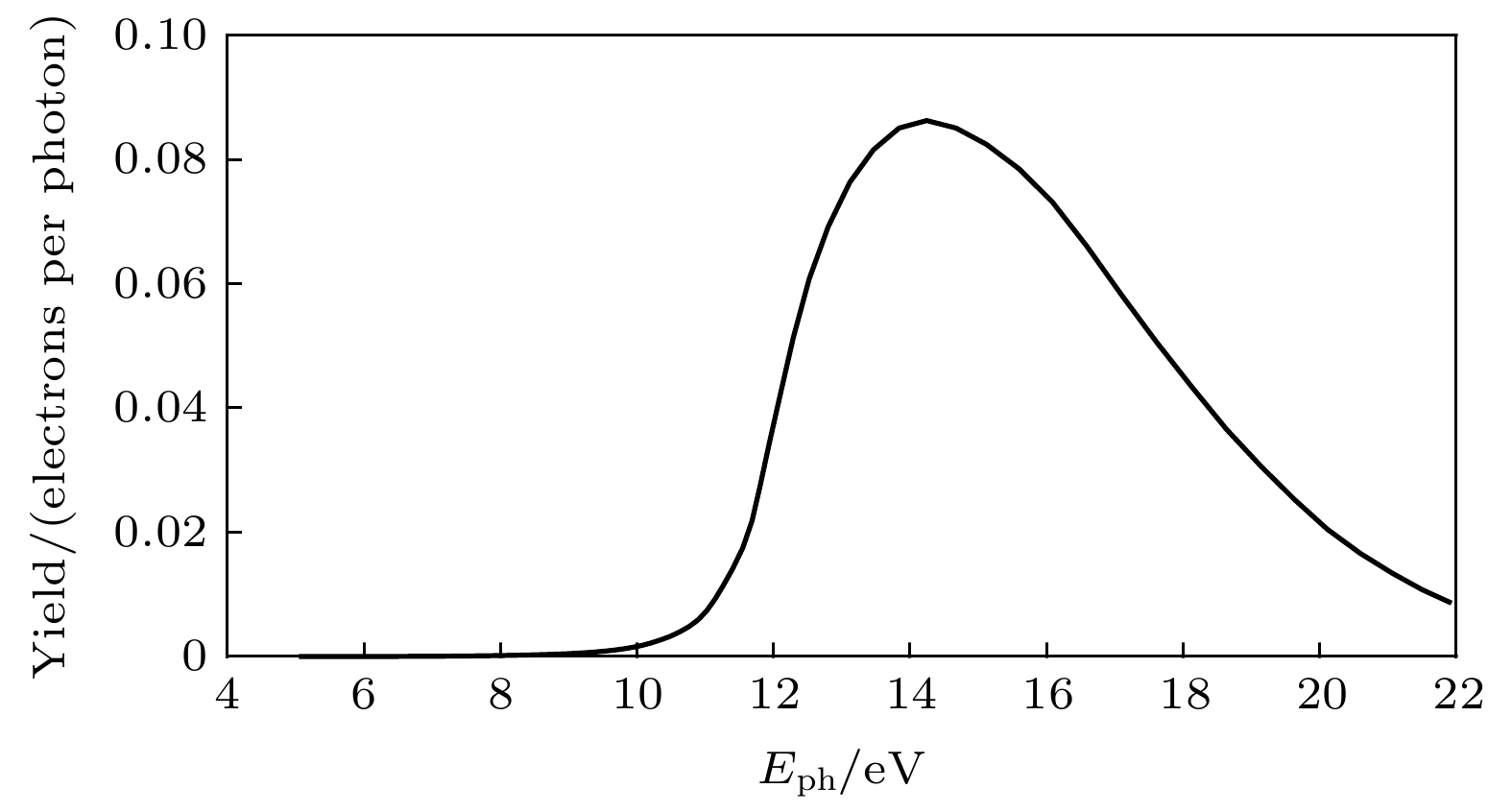
 下载:
下载:
